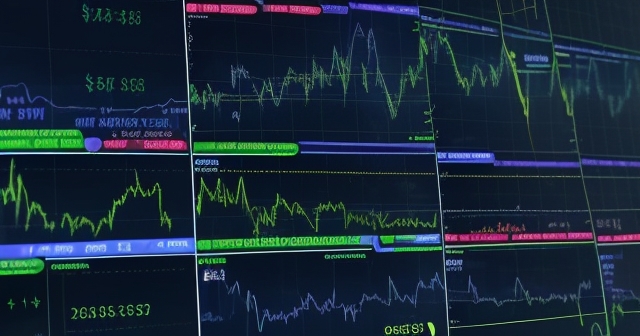
Dollar Index Outlook: A Guide to Navigating Financial Markets
Table of Contents
ToggleUnderstanding the US Dollar Index: A Compass for Global Markets
Welcome to our journey into the world of global finance, specifically focusing on a vital benchmark: the US Dollar Index, often referred to as the DXY or USDX. Think of the DXY as a barometer measuring the relative health and strength of the US Dollar against a select group of other significant global currencies. Just as a ship navigates using a compass, understanding the DXY’s movements can help us navigate the complex seas of the financial markets. Whether you are just starting to explore investment or are a seasoned trader looking to deepen your technical analysis skills, grasping what drives the Dollar Index is absolutely fundamental. It influences not just forex pairs but also commodities like Gold and Oil, and even broader market sentiment.
- The DXY serves as an essential indicator of the dollar’s strength in the global market.
- Changes in the DXY can significantly impact international trade and investment flows.
- Understanding DXY trends enhances investment decision-making across asset classes.
Why does the Dollar Index matter so much? Because the United States economy and its monetary policy, primarily set by the Federal Reserve (the Fed), have an outsized impact on global finance. When the Dollar strengthens, it can make US exports more expensive and foreign imports cheaper. It affects the cost of borrowing for countries and companies that hold debt denominated in Dollars. For investors, understanding its direction is key to forecasting price movements in many asset classes. In this comprehensive analysis, we will break down the complex factors influencing the DXY outlook, from the Fed’s crucial decisions on interest rates to the nitty-gritty of economic data and even the unpredictable winds of trade policy and geopolitics.
Deconstructing the DXY: What Currencies Make Up the Index?
Before we dive into predicting the future, let’s understand the foundation. The US Dollar Index is not just a simple average. It’s a geometrically weighted index tracking the value of the US Dollar relative to a basket of six major world currencies. This index was established in 1973 after the dissolution of the Bretton Woods Agreement, starting with a base value of 100.000. The currencies included, and their approximate weightings (as of 1999, which still largely apply), are:
| Currency | Approximate Weighting |
|---|---|
| Euro (EUR) | 57.6% |
| Japanese Yen (JPY) | 13.6% |
| British Pound (GBP) | 11.9% |
| Canadian Dollar (CAD) | 9.1% |
| Swedish Krona (SEK) | 4.2% |
| Swiss Franc (CHF) | 3.6% |
Notice the dominant role of the Euro. This is critical. Because the Euro makes up more than half of the index’s composition, events or economic conditions that significantly impact the Euro will have a disproportionately large effect on the overall Dollar Index. For example, if political instability in Europe causes the Euro to weaken, the DXY will likely strengthen, all else being equal. Conversely, robust economic growth or a hawkish stance from the European Central Bank could support the Euro and weigh on the DXY.
This structure means that while we are looking at the Dollar’s value, we are simultaneously analyzing the relative strength or weakness of its component currencies. Understanding the individual economic and political landscapes of the Eurozone, Japan, the UK, Canada, Sweden, and Switzerland provides deeper insight into the DXY’s movements. It’s not just about the United States; it’s a relative game.
The Federal Reserve: The Unquestioned Maestro of the Dollar’s Fate
If the DXY is an orchestra, the Federal Reserve is undoubtedly the conductor. The Fed’s monetary policy decisions are the single most influential factor driving the US Dollar Index’s performance. Through its setting of benchmark interest rates (the Federal Funds Rate) and its balance sheet policies (like Quantitative Easing – QE or Quantitative Tightening – QT), the Fed directly impacts the attractiveness of holding Dollar-denominated assets, particularly US Treasury bonds. Higher interest rates in the US relative to other countries tend to attract foreign capital seeking better yields, increasing demand for the Dollar and thus strengthening the DXY. Lower rates, conversely, can make the Dollar less attractive, potentially leading to weakness.
| Factor | Impact on DXY |
|---|---|
| Interest Rates | Higher rates strengthen the DXY |
| Quantitative Easing | May weaken the DXY |
| Foreign Capital Inflow | Increases DXY value |
Currently, the market is intensely focused on the Fed’s path forward regarding interest rates. After a period of aggressive hiking to combat high inflation, the discussion has shifted to when, and how many, rate cuts we might see. Recent commentary from Fed officials and the latest economic projections (as seen in the June 2024 data, for instance) indicate a cautious approach. The central bank seems to be signaling potentially only one rate cut in 2024, likely pushed towards the end of the year, perhaps December. This recalibration of expectations – from potentially multiple cuts earlier in the year to maybe just one – has provided significant support for the Dollar, helping the DXY hold near recent highs despite fluctuating data releases.
Every statement from Fed Chair Jerome Powell or other influential governors is scrutinized by markets for clues about their thinking. The minutes from FOMC (Federal Open Market Committee) meetings are dissected line by line. Why? Because the Fed’s forward guidance on monetary policy creates expectations, and these expectations move markets even before the actual policy change occurs. If the market believes a rate cut is imminent, the Dollar may weaken in anticipation. If the market is surprised by hawkish language or a delay in expected cuts, the Dollar can see a significant rebound or strengthening. Understanding the Fed’s dual mandate (maximum employment and price stability) and how recent economic data is influencing their view is paramount to forecasting the DXY’s outlook.
The Economic Data Pulse: Gauging the Health of the US Economy
While the Fed conducts, the economy provides the sheet music. The health of the United States economy, as measured by a stream of key economic data releases, is the primary input the Fed uses to make its decisions, and it also directly influences investor sentiment towards the Dollar. Let’s look at some of the most critical indicators:
| Economic Indicator | Implications |
|---|---|
| Nonfarm Payrolls (NFP) | Strong NFP can support the Dollar |
| Inflation Data (PCE and CPI) | Sticky inflation may support higher rates |
| Gross Domestic Product (GDP) | Strong GDP growth supports the Dollar |
| Retail Sales | Strong sales suggest healthy consumer demand |
| Purchasing Managers’ Index (PMI) | Strong PMI indicates economic expansion |
Monitoring these and other indicators like consumer sentiment, import/export prices, and unemployment rates provides a clearer picture of the economic landscape the Fed is navigating. Each data point adds a piece to the puzzle, shaping expectations for future monetary policy and, consequently, the DXY’s outlook.
Beyond Economics: The Impact of Trade Policy and Geopolitical Winds
While monetary policy and economic data are primary drivers, the US Dollar Index is also susceptible to broader political and geopolitical forces. Two key areas stand out:
- Trade Policy, particularly US-China Tariffs: The ongoing trade dispute between the United States and China, characterized by the imposition and threat of tariffs, is a significant source of uncertainty. Tariffs can increase the cost of imported goods, potentially contributing to inflation (a factor the Fed watches) and disrupting global supply chains. More broadly, trade tensions can weigh on business confidence, curb investment, and lead to an economic slowdown not just in the involved countries but globally. This risk of economic drag acts as a potential downside pressure on the Dollar, even if the initial imposition of tariffs might sometimes briefly boost it as a ‘safe haven’ asset amidst uncertainty. Developments suggesting an easing of trade tensions can provide temporary support for the Dollar, while escalations or prolonged uncertainty weigh on market sentiment and the long-term DXY outlook.
- Geopolitical Factors and Political Turmoil: As we discussed, the Euro’s heavy weighting in the DXY means that political and economic stability within the Eurozone is critical. Political turmoil in Europe, such as unexpected election results or significant shifts in policy, can weaken the Euro as investors become concerned about economic stability or future policy direction. This weakness in the Euro, in turn, automatically strengthens the DXY. Similarly, major global events – conflicts, crises in other significant economies, or shifts in international relations – can trigger periods of ‘risk-off’ sentiment, where investors flee perceived riskier assets (like emerging market currencies or stocks) and flock to perceived safer assets like the US Dollar or Gold. In these moments, the Dollar can strengthen regardless of immediate economic data or Fed expectations, purely driven by its safe-haven status.
These external pressures add layers of complexity to the DXY forecast. They are often less predictable than economic data releases but can cause sharp, sudden movements. Keeping an eye on global headlines is therefore essential for anyone tracking the US Dollar Index.
Navigating with Technicals: Charting the Dollar’s Course
Beyond the fundamental drivers of policy and economics, technical analysis provides valuable insights into the US Dollar Index’s price action. Technical analysis involves studying historical price charts to identify patterns, trends, and key levels where buying or selling pressure is likely to emerge. For the DXY, just like any other traded asset, traders use various technical tools to inform their decisions.
- Technical analysis identifies potential support and resistance levels for trading.
- Moving averages reveal trends and potential reversals in the DXY.
- Indicators like RSI help assess market sentiment and overbought or oversold conditions.
One of the most commonly watched technical indicators is the relationship between the current price and key moving averages (SMAs). The 200-day Simple Moving Average and the 200-week Simple Moving Average are particularly significant. These long-term averages are often seen as indicators of the prevailing long-term trend. If the DXY is consistently trading below its 200-day SMA or 200-week SMA, it is often interpreted as indicating a longer-term bearish bias or downtrend. Conversely, trading above these levels can suggest a bullish trend. As seen in some data periods, the DXY trading below these key long-term averages can signal underlying weakness over a longer timeframe, even if it experiences short-term rallies.
Identifying support levels and resistance levels is also crucial. A support level is a price point or zone where buying interest is historically strong enough to potentially halt a price decline. A resistance level is a price point or zone where selling pressure is historically strong enough to potentially halt a price advance. These levels can be based on previous highs or lows, psychological numbers (like 100.00 on the DXY), or derived from indicators like pivot points. For example, the psychological level of 100.00 has often acted as a significant pivot point for the DXY in the past.
Technical traders look for the DXY to test or break through these levels. A decisive break above a resistance level can signal potential for further gains, while a break below a support level can indicate potential for further losses. Other technical indicators like the Relative Strength Index (RSI), which measures the speed and change of price movements to identify overbought or undersold conditions, and the Average Directional Index (ADX), which measures trend strength, can provide additional confirmation or warning signals.
While technical analysis alone cannot predict the future, it provides a framework for understanding current market sentiment and potential price paths based on historical behavior. Combining fundamental analysis (understanding the drivers) with technical analysis (understanding the chart picture) offers a more robust approach to forming a view on the DXY outlook.
How the Dollar Index Interacts with Other Markets
The US Dollar Index’s movements do not occur in isolation; they ripple across the entire financial ecosystem. Understanding these relationships is key for any global investor or trader.
- Forex traders monitor DXY for insights into major currency pairs.
- Global commodity prices fluctuate based on the strength of the Dollar.
- US Treasury yields influence capital flows and demand for Dollars.
For forex traders, the connection is direct. The DXY is composed of major currency pairs like EUR/USD, GBP/USD, and USD/JPY (though USD is the base currency in the DXY calculation for EUR, GBP, CAD, SEK, CHF, and the quote currency for JPY). When the DXY strengthens, it typically means the Dollar is gaining value against its basket. This often translates to a weakening of pairs where the Dollar is the quote currency (like EUR/USD or GBP/USD) and a strengthening of pairs where the Dollar is the base currency (like USD/JPY). Conversely, DXY weakness usually correlates with strength in EUR/USD and GBP/USD, and weakness in USD/JPY. Therefore, analyzing the DXY provides a macro view that can inform strategies for individual currency pairs.
Commodities are also highly sensitive to the Dollar’s value. Many key commodities, such as Gold and Oil, are priced in US Dollars globally. When the Dollar strengthens, these commodities become more expensive for buyers using other currencies, which can decrease demand and put downward pressure on their prices. Conversely, a weaker Dollar makes commodities cheaper for international buyers, potentially boosting demand and supporting prices. This inverse relationship is why you often see Gold prices decline when the DXY strengthens and rally when the DXY weakens, though other factors specific to the commodity’s supply and demand dynamics also play a crucial role.
The relationship between the Dollar Index and US Treasury Yields is another critical linkage. Higher US Treasury yields, particularly on benchmark bonds like the 10-year or 2-year Treasury, increase the attractiveness of holding Dollar-denominated assets. This can draw foreign capital into US debt markets, increasing demand for the Dollar and supporting the DXY. Yields are heavily influenced by Fed policy expectations and inflation outlooks, reinforcing the central role of the Fed in this interconnected system.
Even stock markets can be influenced. A strong Dollar can potentially weigh on the earnings of US multinational corporations as foreign profits translate back into fewer Dollars. However, the relationship is complex and often intertwined with the reasons *why* the Dollar is strong (e.g., if it’s due to robust US economic growth, stocks might also be doing well). During periods of high market stress or ‘risk-off’ sentiment, the Dollar can strengthen as investors reduce exposure to riskier assets like stocks and seek the perceived safety of the Greenback.
For those considering trading these interconnected markets, understanding the relationships is vital. If you’re interested in trading forex or other instruments influenced by Dollar movements, having access to robust platforms and diverse instruments is key. If you’re just starting to explore foreign exchange trading or explore more CFD products, then Moneta Markets is a platform worth considering. It comes from Australia and offers over 1000 financial instruments, suitable for both beginners and professional traders alike.
Upcoming Catalysts and What to Monitor
The financial markets are dynamic, and the US Dollar Index outlook is constantly being reshaped by new information. Staying informed about upcoming catalysts is essential for anyone tracking the DXY. Some of the most critical events to watch include:
- Federal Reserve Meetings (FOMC): These scheduled meetings, held approximately every six weeks, are where the Fed makes decisions on interest rates and other aspects of monetary policy. The accompanying statement, economic projections, and press conference (often featuring Jerome Powell) are devoured by markets for clues about the future path of policy. Unexpected decisions or shifts in tone can cause significant Dollar volatility.
- Key Economic Data Releases: As discussed, reports like Nonfarm Payrolls, CPI/PCE inflation, GDP, and Retail Sales are market movers. Pay close attention to the actual figures versus market expectations. Surprises often lead to immediate price reactions in the DXY and related markets. Upcoming flash PMI data will also provide fresh insights into economic momentum.
- Speeches and Commentary from Fed Officials: Beyond the scheduled meetings, various Fed governors, including regional Fed presidents like Neel Kashkari, often give speeches or interviews. Their commentary can provide hints about the internal thinking within the Fed and influence market expectations for policy, thus impacting the Dollar.
- Developments in Trade Policy: Any news regarding negotiations, potential new tariffs, or changes in trade relations between the US and major partners like China will be closely watched for its potential economic impact and its effect on global risk sentiment.
- Major Geopolitical Events: Significant political developments in Europe (given the Euro’s weight), or other major global regions, as well as any escalation or de-escalation of international tensions, can trigger safe-haven flows and impact the DXY.
Monitoring these catalysts allows you to anticipate periods of potential increased volatility and understand the rationale behind market movements. It’s not just about knowing *what* is happening, but *why* it matters to the Dollar Index.
The Current DXY Landscape and Future Trajectory
Bringing it all together, what does the current picture suggest for the US Dollar Index outlook? Recent data points, such as better-than-expected Nonfarm Payrolls, have demonstrated underlying resilience in the US economy, which has helped to cool some of the earlier expectations for aggressive Fed rate cuts. This recalibration, where the market now prices in perhaps just one cut in 2024 (likely late in the year), has been a key factor supporting the Dollar’s strength or preventing significant weakness. We’ve seen the DXY holding near recent highs, reflecting this adjusted policy outlook.
However, challenges and uncertainties remain. Inflation, while lower than its peak, remains stickier than the Fed would prefer, creating a dilemma if economic growth were to slow more significantly (the stagflation risk). The potential economic impact of trade protectionism, particularly the lingering effects and future threats of US-China tariffs, continues to cast a shadow, representing a potential downside risk for the Dollar outlook. Furthermore, political events in Europe or other major regions could introduce external pressures via the Euro’s influence or shifts in global risk appetite.
From a technical perspective, while the DXY has shown recent strength, its position relative to key long-term indicators like the 200-day SMA needs careful observation. If the DXY is trading below these levels over a sustained period, despite short-term rallies, it could suggest that the longer-term bias remains bearish, and recent gains are counter-trend movements. Key support and resistance levels, such as the psychological 100.00 mark or recent highs/lows, will serve as important indicators for directional changes.
The trajectory of the DXY in the near term is likely to remain heavily data-dependent and sensitive to Fed communications. If incoming data suggests stronger economic momentum and persistent inflation, further delaying expected rate cuts, the Dollar could see continued support. Conversely, signs of significant economic cooling or a faster-than-expected decline in inflation could increase the probability of earlier or more numerous rate cuts, likely weighing on the Greenback. Any significant escalation or de-escalation on the trade front will also be a major factor.
Navigating these complexities requires both a solid understanding of the fundamentals and the ability to interpret technical signals. For those engaging in trading based on these analyses, having a reliable and efficient trading platform is crucial. When choosing a trading platform, Moneta Markets’ flexibility and technical advantages are worth noting. It supports mainstream platforms like MT4, MT5, and Pro Trader, combining high-speed execution with low spread settings, providing a good trading experience.
Risk Management in a Volatile Dollar Environment
Given the numerous factors influencing the US Dollar Index – ranging from predictable economic reports to unpredictable geopolitical shocks – volatility is a constant companion. For traders and investors, this underscores the absolute necessity of robust risk management. Predicting currency movements with certainty is impossible; markets can react unexpectedly to news or simply shift sentiment without an obvious trigger.
- Implementing effective risk management is critical in volatile environments.
- Proper position sizing helps mitigate excessive losses.
- Emotional discipline supports adherence to trading plans amid sudden market shifts.
Effective risk management in this environment involves several key components. Firstly, never risk more capital on a single trade or investment than you can afford to lose. Position sizing is crucial – determine the appropriate size of your trade based on your account capital and the level of volatility in the market. Secondly, utilizing tools like stop-loss orders is fundamental. A stop-loss order automatically closes a trade if the price moves against you by a specified amount, limiting potential losses. While stop losses aren’t guaranteed in all market conditions (like extreme gaps), they are a vital layer of protection.
Diversification across different asset classes or currency pairs can also help mitigate risk, although focusing heavily on DXY-related pairs inherently concentrates some risk. Understanding the potential impact of major upcoming catalysts allows you to either reduce exposure or widen your risk parameters around those events. For example, approaching a major Fed announcement with smaller position sizes or wider stop losses can help you weather potential price swings.
Furthermore, maintaining emotional discipline is critical. Market moves can be sharp and sudden, triggering fear or greed. Sticking to a pre-defined trading plan based on your analysis, rather than making impulsive decisions driven by short-term price action, is key to long-term success. The DXY’s importance means that reactions to news can be amplified, making a calm and calculated approach even more vital.
Long-Term Trends vs. Short-Term Noise
When analyzing the US Dollar Index, it’s important to distinguish between long-term trends driven by fundamental shifts in monetary policy or economic structure and short-term noise caused by daily data releases, intraday trading fluctuations, or minor news events. While technical analysis using shorter-term charts (e.g., hourly or daily) can help capture short-term swings, understanding the bigger picture requires looking at longer-term charts (weekly or monthly) and focusing on the overarching fundamental drivers.
The Fed’s policy trajectory, particularly the pace and extent of any future rate cuts, will likely be the dominant factor shaping the multi-month or even multi-year DXY outlook. Significant shifts in global trade dynamics or sustained economic performance divergences between the US and other major economies will also contribute to longer-term trends. Short-term data surprises or temporary geopolitical flare-ups can cause significant *movements* but may not necessarily alter the underlying trend unless they are persistent or fundamentally change the economic or policy outlook.
For investors with a longer-term perspective, focusing on the structural factors – where is the Fed heading? What is the long-term inflation outlook? How is the US economy performing relative to its peers? – is more important than getting caught up in every single daily fluctuation. For active traders, however, understanding both the long-term bias and the short-term catalysts is necessary to navigate the market effectively. Identifying whether short-term moves are in line with or counter to the dominant trend is a key skill.
In Conclusion: The Dollar Index as Your Financial Barometer
As we’ve explored, the US Dollar Index (DXY) is far more than just a number; it’s a complex indicator influenced by a confluence of powerful forces. It acts as a barometer for the relative value of the US Dollar and provides crucial insights into global economic health, monetary policy expectations, and market sentiment. Understanding what drives the DXY – primarily the actions and guidance of the Federal Reserve, the flow of key economic data (from NFP and inflation to GDP and retail sales), and external pressures from trade policy and geopolitics – is essential for anyone participating in the global financial markets.
While recent resilience in the US economy and recalibrated Fed rate cut expectations have provided support for the Dollar, challenges remain. Sticky inflation, potential risks from trade tensions, and unpredictable geopolitical events introduce layers of uncertainty and the potential for continued volatility. Both fundamental and technical analysis offer valuable perspectives, and combining them provides a more comprehensive view.
Monitoring upcoming catalysts like FOMC meetings, major data releases, and statements from figures like Jerome Powell is crucial for staying ahead of potential market shifts. For those looking to leverage this knowledge in their trading activities, selecting a platform that provides the necessary tools and reliability is key. If you are seeking a foreign exchange broker with regulatory protection and the ability to trade globally, Moneta Markets holds multi-jurisdiction regulatory licenses including FSCA, ASIC, and FSA. They offer features like segregated client funds, free VPS, and 24/7 Chinese customer support, making them a preferred choice for many traders.
Ultimately, the US Dollar Index outlook will continue to evolve. By focusing on the core drivers, staying informed about new information, employing sound risk management practices, and utilizing appropriate trading resources, you can better navigate the complexities of the currency markets and potentially improve your trading and investment outcomes. The journey to mastering financial markets is continuous, and understanding the DXY is a vital step along the way.






dollar index outlookFAQ
Q:What factors influence the US Dollar Index?
A:The US Dollar Index is influenced by the Federal Reserve’s monetary policy, economic data such as employment and inflation, and geopolitical stability.
Q:How does the Dollar Index affect forex trading?
A:A strengthening Dollar Index typically indicates a stronger US dollar, impacting currency pairs and potentially leading to trading strategies focused on major forex pairs.
Q:What role do commodities play in relation to the Dollar Index?
A:Many commodities are priced in US dollars, so a stronger Dollar Index can make these commodities more expensive for foreign buyers, potentially decreasing demand and influencing prices.
You may also like
Calendar
| 一 | 二 | 三 | 四 | 五 | 六 | 日 |
|---|---|---|---|---|---|---|
| 1 | 2 | 3 | 4 | 5 | 6 | 7 |
| 8 | 9 | 10 | 11 | 12 | 13 | 14 |
| 15 | 16 | 17 | 18 | 19 | 20 | 21 |
| 22 | 23 | 24 | 25 | 26 | 27 | 28 |
| 29 | 30 | 31 | ||||
發佈留言
很抱歉,必須登入網站才能發佈留言。